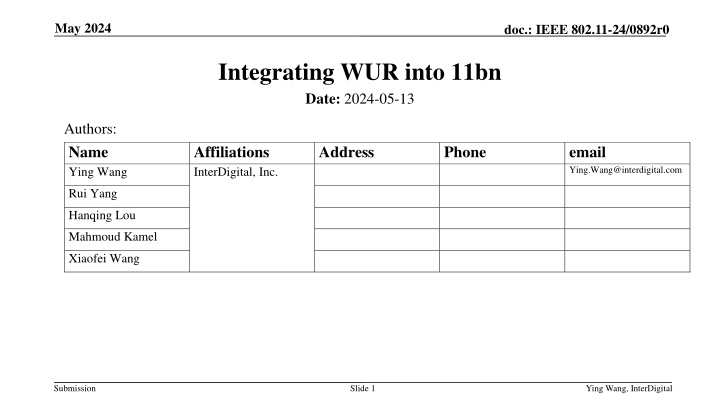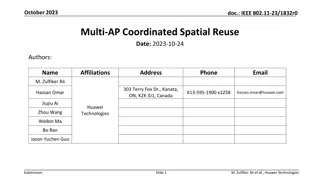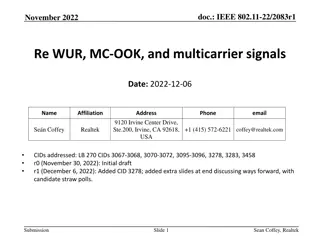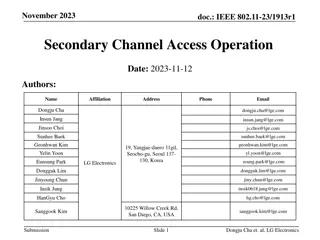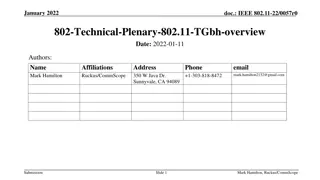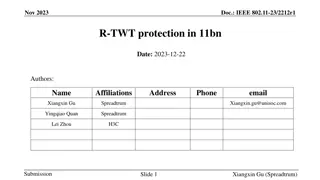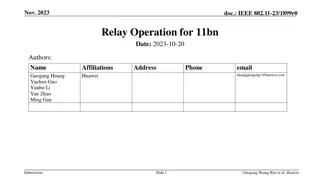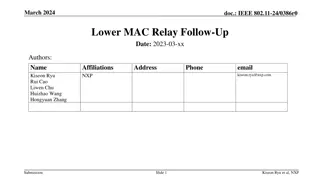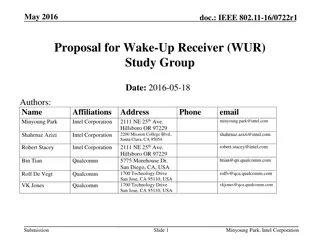Integrating WUR into IEEE 802.11bn for Enhanced Network Efficiency
IEEE 802.11-24/0892r0 proposes integrating Wake-Up Radio (WUR) technology into 11bn networks to improve reliability, support low latency traffic, increase peak throughput, and enhance power-saving capabilities. The WUR acts as a companion radio to the main connectivity radio, enabling power-saving while accommodating low-latency requirements. Various methods are discussed, including utilizing WUR as a companion radio to UHR devices and aggregating WUR PPDUs with UHR PPDUs for enhanced network efficiency, throughput, and latency performance.
Download Presentation

Please find below an Image/Link to download the presentation.
The content on the website is provided AS IS for your information and personal use only. It may not be sold, licensed, or shared on other websites without obtaining consent from the author.If you encounter any issues during the download, it is possible that the publisher has removed the file from their server.
You are allowed to download the files provided on this website for personal or commercial use, subject to the condition that they are used lawfully. All files are the property of their respective owners.
The content on the website is provided AS IS for your information and personal use only. It may not be sold, licensed, or shared on other websites without obtaining consent from the author.
E N D
Presentation Transcript
May 2024 doc.: IEEE 802.11-24/0892r0 Integrating WUR into 11bn Date: 2024-05-13 Authors: Name Ying Wang Affiliations InterDigital, Inc. Address Phone email Ying.Wang@interdigital.com Rui Yang Hanqing Lou Mahmoud Kamel Xiaofei Wang Submission Slide 1 Ying Wang, InterDigital
May 2024 doc.: IEEE 802.11-24/0892r0 Motivation 11bn UHR aims to improve reliability support further reduced low latency traffic further increase peak throughput improve power saving capabilities improve network efficiency Introducing 802.11ba WUR to 11bn Power saving while supporting low-latency traffic There is a trade-off with throughput and efficiency Submission Slide 2 Ying Wang, InterDigital
May 2024 doc.: IEEE 802.11-24/0892r0 Brief Recap on 802.11ba (1) The 802.11ba WUR is a companion radio to the primary connectivity radio or the main radio (MR) that supports 802.11 standards such as non-HT, HT, VHT, or HE The main radio would stay in deep sleep mode most of the time and only turn on to transfer data when the WUR receives a wake-up message. WUR requirements [1] The wake-up frames carry only control information that can trigger a transition of the primary connectivity radio out of sleep. The WUR meets the same range requirement as the primary connectivity radio The WUR devices coexist with legacy IEEE 802.11 devices in the same band The WUR has an expected active receiver power consumption of less than one milliwatt. Submission Slide 3 Ying Wang, InterDigital
May 2024 doc.: IEEE 802.11-24/0892r0 Brief Recap on 802.11ba (2) [2] WUR PPDU structure Non-WUR portion: OFDM signaling, 20MHz Coexisting with other 802.11 devices operating in the same frequency band WUR portion: OOK signaling, 4.5MHz Sync: for WUR PPDU detection, data rate detection, timing alignment, 2us/logic bit Data: LDR(mandatory)/HDR; Manchester coding, 2us or 4us per encoded bit WUR FDMA PPDU 40MHz and 80MHz support WUR MAC frame types Beacon, Discovery, Wake-up, Short Wake-up, Vendor Specific 4-24 bytes, LDR: 0.668-2.972ms, HDR: 0.22-0.796ms Submission Slide 4 Ying Wang, InterDigital
May 2024 doc.: IEEE 802.11-24/0892r0 Method 1: WUR as Companion Radio to UHR Introduce WUR as is to UHR UHR devices are equipped with a WUR as companion radio May need to extend WUR FDMA PPDU support to 160MHz and 320MHz Power saving benefit MR in listen mode (55~80mw) vs. various sleep modes (deep: 0~100uw with >3ms sleep-to-active latency; shallow: ~1mw, <500us; micro: ~5mw, <100us) [3] WUR <1 mw Issues with efficiency and throughput LDR WUR frames could be up to 3ms WUR FDMA PPDU helps, but not enough What if WUR PPDUs don t need all the available bandwidth? If a WUR frame is sent every 200ms, the WUR network utilization time is 1.5% But what about more APs or more frequent WUR frames at different times? Submission Slide 5 Ying Wang, InterDigital
May 2024 doc.: IEEE 802.11-24/0892r0 Method 2: A-PPDU with WUR signals Aggregate WUR PPDUs with UHR PPDUs for improved efficiency, throughput, latency while reaping the power saving benefit Simultaneous WUR and UHR transmission for better utilization of the available bandwidth Flexible to accommodate low-latency UHR traffic Feasibility in the PHY perspective Very feasible in 20MHz subchannel-level aggregation FDMA, not OFDMA, but Transmit spectrum mask assures that the mutual interference level is as low as not mixing WUR and UHR signals RU-level aggregation is more efficient, but needs further feasibility study Slide 6 Submission Ying Wang, InterDigital
May 2024 doc.: IEEE 802.11-24/0892r0 Summary WUR as a companion radio could benefit UHR devices with huge power saving Enabling A-PPDU with WUR signals integrate the WUR feature to UHR with more flexibility and improved efficiency More study is needed on feasibility, signal generation, signaling, etc. Submission Slide 7 Ying Wang, InterDigital
May 2024 doc.: IEEE 802.11-24/0892r0 References 1. IEEE 802.11-16/1045r9, A PAR Proposal for Wake-up Radio, Jul. 2016. 2. IEEE P802.11-REVme /D5.0: Wireless LAN Medium Access Control (MAC) and Physical Layer (PHY) Specifications, February 2024 3. IEEE 802.11-15/0314r2, Sleep States in IEEE 802.11ax Simulation Scenarios, March 2015. Submission Slide 8 Ying Wang, InterDigital
May 2024 doc.: IEEE 802.11-24/0892r0 Appendix - More on 802.11ba (1) [2] Non-WUR portion: OFDM signaling decoded as an 11a PPDU indicates the duration of the PPDU (modulo 3 = 0) Code bits in BPSK-mark1/2 are the logical complement of the code bits in L-SIG WUR portion: OOK signaling Sync: for WUR PPDU detection, data rate detection, timing alignment LDR 128us (W,W), 2us/logic bit HDR 64us ( ?), 2us/logic bit Data: LDR(mandatory)/HDR; Manchester coding LDR 62.5kb/s, 16us/info bit, 4us/encoded bit HDR 250kb/s, 4us/info bit, 2us/encoded bit [2] Submission Slide 9 Ying Wang, InterDigital
May 2024 doc.: IEEE 802.11-24/0892r0 Appendix - More on 802.11ba (2) [2] OOK signals Effective 4.5MHz bandwidth 2us or 4us ON/OFF WUR MAC frame types Beacon, Discovery, Wake-up, Short Wake-up, Vendor Specific 4-24 bytes, LDR: 0.668-2.972ms, HDR: 0.22-0.796ms WUR FDMA PPDU 40MHz and 80MHz support Submission Slide 10 Ying Wang, InterDigital
